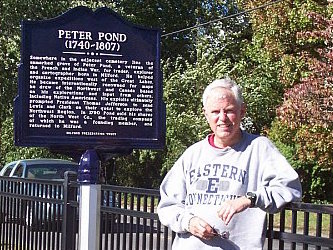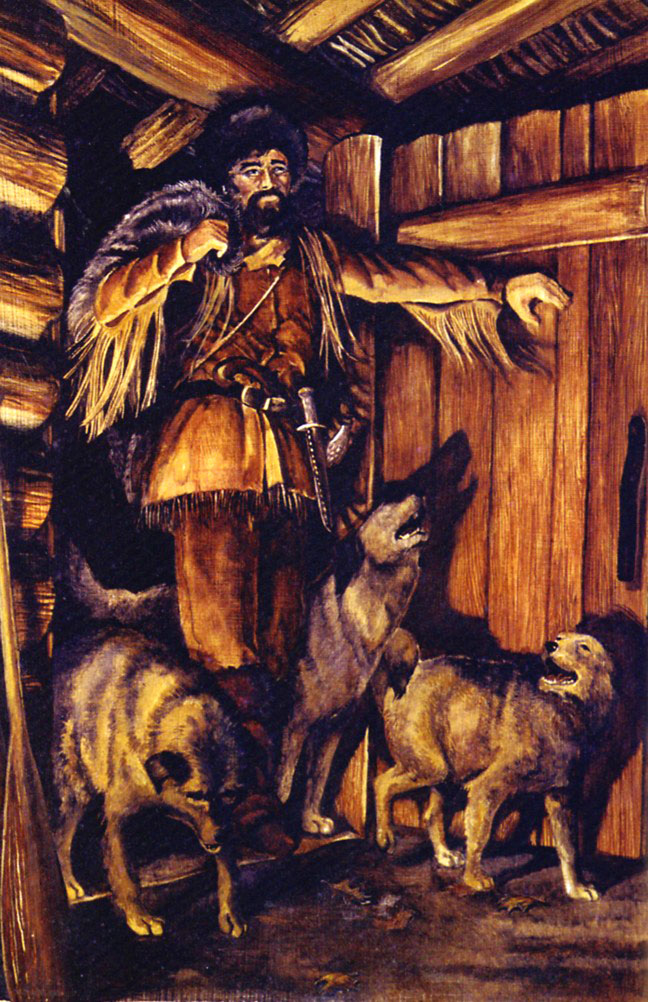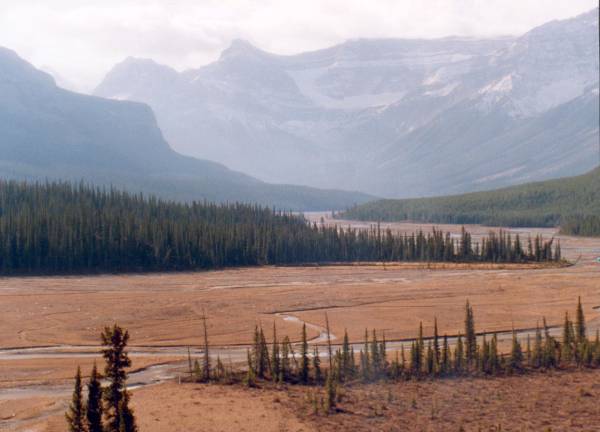Peter Pond newsletter :: December 2006 :: #26
Hello again and happy holidays. What a newsy year! Let's get on with the latest before the year runs out.
ARTIFACTS UPDATE:
You'll remember a recent newsletter discussing artifacts (assorted jewelry trinkets for trading, parts of pipes, guns, bullets, belt buckles, bird and animal bones, bottles) unearthed from an archeological dig at Peter Pond's Sturgeon Fort site of 1777-78 near Prince Albert, SK. After spending close to a half century in Virginia, the artifacts were repatriated to Parks Canada, Winnipeg, two years ago and are just about finished being photographed and catalogued. Though I'm told most are unattractive, some are good enough for a future exhibition. Will let you know when things are more official.
Jennifer Hamilton, collections archeologist responsible for the artifacts, cautions that the exhibition probably won't take place before 2008.
Another interested Winnipeg-based person is Bruce Shepard, director, research, collections and exhibits for the Manitoba Museum in that city. You might know that museum has all of the Hudson's Bay Co. collection. You can see Bruce left a short message in my Peter Pond Society guest book Nov. 1 ("I am interested in the American presence in Western Canada, and Peter Pond is one of the 'originals'.") We corresponded and I eventually induced him to go over and visit the Peter Pond collection. His note of 12/11 called them "interesting, but not that impressive." But he didn't see everything since the visit was cut short by a fire alarm and all had to vacate the building. He plans to go back after the first of the year. Stay tuned.
DAVID THOMPSON (1770-1857):
Not to steal Peter Pond's thunder, but it's interesting to see how much is being made of celebrating the David Thompson Bicentennial coming in 2008. He had such an adventurous life. After extensive traveling, he made the first complete map of Canada which remains among the nation's great documents. He acknowledged through several sources being influenced by Peter Pond. We know Peter Pond made the first maps going west of Hudson Bay. DT died in poverty, was buried in Mount Royal Cemetery, Montreal, in an unmarked grave. Sound familiar? But the Champlain Society found it and placed an impressive column on the spot. The 2007-2010 period commemorates his travels and making the map 200 years ago. Here's whole story 2008 David Thompson Brigade planning to canoe from Rocky Mountain House, AB, to Thunder Bay, ON, May-July 2008. Its collection of links on Thompson and the fur trade is impressive.
DT's famous map, which you can expand to several times the size Thanks to my recently received issue of CHE-MUN for mentioning it.
Also note photo of Mount David Thompson in Banff National Park, AB, renamed in September from the former "Mount David" to better identify the honoree. It was sent to me by Pat McDonald of Rocky Mountain House, a Peter Pond Society member. Left of center in photo, the mountain is in Howse Pass, traversed by DT in 1807.
OUTWARD BOUND HONORS Peter Pond:
Here's another interesting item that came out of my guest book recently. His name is Peter Reynolds and it looks like he's a teacher someplace in Vermont. We traded emails briefly, then he dropped away. But not before I got this interesting message. Interesting company Peter Pond was keeping with those canoes. I'm still trying to contact Outward Bound about this but they don't seem to respond in the winter off-season. Wonder if any of you have connections.
"In the 70's (my 20's) I was an instructor at the Minnesota (now Voyageur) OB School in the Boundary Waters Canoe Area--the Quetico-Superior region. We traveled by canoe for up to three weeks at a time in groups of ten. Each ten-group was called a brigade. The women's brigades were Ojibway names, the men's historical characters from the beaver trading days: Lagimoniere, MacKenzie, Henry, Thomson, Radisson, Tanner, Verendrye, and--of course--Pond. The four canoes in each brigade had on one bow the Outward Bound shield and on the other the brigade's shield reflecting some aspect of the namesake, much as did first the natives canoes and later those of the trading companies. As I remember, Pond's had the tools of the mapmaker.
I returned after thirty years to again instruct two summers ago. I was pleased by how much of the culture of the place remained. I was disappointed that the use of brigade names had devolved into signs on equipment cages. There was little history available. I have offered to bring it more up-to-date. Your website did that."
Peter Reynolds
Teacher/Geographer
Appleseed Geographics
geogrifying American classrooms sm
TOMBSTONE QUANDARY:
As mentioned before, Peter Pond's grave is currently unmarked, though I'm pretty certain he's buried someplace in Milford. You also remember there was a serious attempt to find his grave in August 2003 by State Archeologist Nicholas Bellantoni. It keeps gnawing at me that perhaps he had a perfectly good gravestone that somehow went missing. To fuel my quandary, here are two newspaper stories about old gravestones that went missing and ended up in strange places. Both are attachments, one from the Hartford Courant that includes Nick discussing such occurrences, the other a wire story about a headstone found in the front yard of 19th century poet Emily Dickinson's home in Amherst, Mass.
TOMBSTONES TURN UP IN STRANGE PLACES
IN SOME CASES, ABANDONED GRAVE MARKERS CAN BE EXPLAINED
Hartford Courant - Hartford, Conn.
Author: LYNN DOAN, Courant Staff Writer
Date: Oct 23, 2006
Start Page: A.1
Section: MAIN (A)
Text Word Count: 839
(Copyright The Hartford Courant 2006)
People claim to live with skeletons in their closets, but tombstones in their basements?
Some Suffield residents don't need Halloween to deck their lawns with graveyard scenes. Old headstones are gathering dust in the basements and backyards of a number of the town's older homes.
In Carol and Thomas Kaput's 18th century home, two tombstones -- one etched with "In Memory of Isaac Griffin" -- lie side-by-side on the basement floor. A small stone that appears to have been carved for an infant rests nearby against the water heater.
"They're all over the place," Carol Kaput said of the tombstones in her house. "We're just waiting for the next one to pop up somewhere.
"At least a half-dozen Suffield families have discovered these seemingly abandoned tombstones, many made of expensive marble, in and around their homes. More have been spotted in deeply wooded areas, on hills and just off public sidewalks in town.
Nick Bellantoni, the state archaeologist, said the small clusters of stones are not uncommon in rural, farming towns across Connecticut, specifically in the eastern and central parts of the state. Many 18th century farmers reserved land for burials, he said.
"Back then, rather than trying to get the body to the town cemetery, it was just easier to bury in the backyard," Bellantoni said.
In North Stonington, a town of 5,000 in northeast Connecticut, locals have counted about 120 "private cemeteries" in backyards and far-off wooded areas, he said. Stones also have been spotted in East Windsor and East Granby homes.
Back in Suffield, Carol Kaput found another headstone shoved into the home's wood-burning stove, apparently to absorb some of the heat. Kaput, a schoolteacher, found the location sacrilegious and dragged the stone, engraved with "Larmon Holcomb/Farewell my friends and children/Keep me in your memory," to her herb garden in the back of the house.
Just behind the front door of another old house in northern Suffield, there's a weathered tombstone in the entryway to Anita Wardell's living room. Time has worn off all engravings.
A second one served as the lid to a water drainage system in the back of the house. When the system was filled with concrete, the Wardells moved the tombstone to the entrance of their patio, where it serves as a stepping stone.
It is etched with the name of Henry Easton, who apparently died in Aug. 1876 at age 59.
"People will walk into the patio and step onto the tombstone and do kind of a double take," said Wardell, whose house dates to the 1730s. "He's become the topic of conversation at quite a few dinner parties."
These conversations have fueled a couple of theories on how the headstones ended up anywhere but in a cemetery.
Kaput has heard from neighbors that a road was once paved through Copper Hill Cemetery, about a mile from her home. To make way for the road, neighbors say, cemetery officials plucked tombstones from the ground and returned them to the families of the departed.
But Kenneth Seymour, who has been a sexton for the cemetery for nearly 15 years, said he couldn't recall such a project.
Janet Banks, a Suffield real estate agent and member of the town's heritage committee, offered a much simpler scenario.
"Families often replaced headstones with fancier ones," said Banks, who recently sold a house with two marble headstones included. "Being Yankees who just couldn't throw away a good piece of marble, they'd bring it back to the farm and put it to good use."
The Yankee theory explains why the two headstones on the property Banks just sold now serve as stepping stones into an old barn.
Both scenarios are possible, Bellantoni said, but chances are that "where there's a tombstone, there's a body."
"Many of the town cemeteries only represent 30 to 40 percent of the town's population at the time," he said. "We don't know where the rest were buried.
"The spooky part: a cluster of five tombstones in a field or open space, Bellantoni said, usually means about 10 bodies are actually beneath the soil.
"African slaves weren't going to get markers," he said.
Particularly in Suffield, town historian Lester Smith said, residents had a reason to bury their dead in "lonesome, distant locations." When a smallpox epidemic struck the town in the 1700s, families decided to bury their infected dead far enough away to prevent the spread of the disease, he said.
One such burial apparently took place on River Boulevard. Both a headstone and footstone belonging to a "Richard Austin" still stand between the road and the riverbank.
Carol Kaput said she believes that her resident tombstones were simply phased out by fancier ones or dug up to make way for a road.
Contact Lynn Doan at ldoan@courant.com.
Headstone found at Dickinson home
By ADAM GORLICK, Associated Press Writer Fri Nov 3, 2006
AMHERST, Mass. - For Emily Dickinson, death was never too far from the imagination. The topic fueled her writing, making for some of the most memorable lyrics in American poetry.
Now, death is posing a bit of a puzzle for the caretakers of her homestead.
While making improvements to the grounds of the Emily Dickinson Museum on Halloween, workers unearthed the gravestone of one of the poet's relatives.
But exactly what Gen. Thomas Gilbert's headstone was doing under 18 inches of dirt in Dickinson's front yard has some experts stumped - especially knowing that his remains are buried in a nearby cemetery with a more ornate grave marker.
"What do you do with a used gravestone?" asked Jane Wald, the museum's executive director. "It might have been used as a step or used to cover a hole in the ground. We don't know exactly why it was placed there."
To be sure, more is known about Gilbert than the simple marble slab that bears his name and date of death. An innkeeper, merchant, lawmaker and member of the Massachusetts militia who lived in Greenfield, Gilbert had seven children and outlived his wife. But when he died a pauper in 1841, his youngest daughter, Susan, moved to Amherst to live with an older sister.
That's where she met Dickinson, when both girls were 14. Their lifelong friendship deepened in 1856, when Emily's brother, Austin, married Susan. To entice the newlyweds into staying in Amherst, Austin and Emily's father built them a house next to the Dickinson homestead.
Susan, who long endured taunts and barbs from Amherst residents who considered her father to be a drunk because he owned a tavern, may have wanted to put her detractors in place by moving her father's grave from Greenfield to Amherst.
When Gilbert and his wife were reburied close to the Dickinson homestead in West Cemetery, their plot was adorned with a new marker. The gravestone dug up earlier this week was likely the original stone from Gilbert's Greenfield grave, Wald suspects.
"In that regard, it makes sense for this grave marker to be found around here," she said.
The marker was found by workers digging a trench to improve water drainage. When their excavation equipment hit slabs of stone, they started digging by hand.
Chunks of marble - some with letters or numbers carved in them - started surfacing. By the time they were done, 15 pieces were unearthed and arranged like an oversized jigsaw puzzle. A few gaps in the slab remain, but the marker clearly reads "Gen. Tho. Gilbert. Died Dec. 23, 1841." The number 48, his age when he died, rests at the bottom.
Wald guesses the gravestone went underground as one piece, but shattered under pressure of time and landscaping equipment that's been rolling over the homestead grounds during the past few years.
Emily Dickinson, who wrote most of her hundreds of poems about nature, love, life and death in her second-floor bedroom, died in 1886. The last surviving member of the Dickinson family was Austin and Susan's daughter, Martha, who sold the homestead in 1916.
It was purchased in 1965 by Amherst College and opened by the school as a museum in 2003.
Other maintenance and repair work has unearthed pieces of ceramics, a mouth harp, coins and a brick gutter.
"There's always a great deal of potential for archaeological finds at a site like this," Wald said.
WHITEHOUSE WINS:
This refers to Sheldon Whitehouse, Democrat and former Rhode Island attorney general who won a U.S. Senate seat over Republican incumbent Lincoln Chafee in November. Why do I care? Because Whitehouse wrote the fabulous tribute (see Newsletter No. 7) to Peter Lawrence Pond who died in July 2000. As I think mentioned before, I have taken to calling him PPY (Peter Pond the Younger) and his 18th century namesake Peter Pond Elder (Peter Pond the Elder) because they mirrored each other so much in temperament if not harrowing adventure. Have another read to see for yourself. So I'm trying to get Senator-elect Whitehouse's attention about Peter Pond Society. I wrote a congratulations note to his campaign email shortly after he won, but I think it got buried, and he was also probably still busy. So I'll write again to his senate office in January once things settle down.
SOCIETY OF THE CINCINNATI:
While we're the subject of Peter Pond Younger, I couldn't resist this as a "small world" encounter. I mentioned before that Peter Pond research has spurred me to delve deeper into my own family history. So after hearing about the possibility for years, I decided to see if I was eligible for membership in the Society of the Cincinnati, a lineage group tracing descent from American Revolutionary War officers. I found I was indeed related to a Virginia officer who was a close friend of George Washington. But I couldn't join since connection to that officer had already been made by a living person. When that person passes away, he plans to hand membership down to his nephew since he has no son. Only one living male at a time related to a given officer can hold society membership. Very exclusive.
So my research encountered the fact that Peter Lawrence Pond of Providence, R.I. had been a society member, until his death, as descendant of Capt. Charles Pond of Milford. Charles, as you might remember, was PPE's younger brother and a naval officer during the Revolution. He his honored in his hometown today by having the local Children of the American Revolution (CAR) chapter named after him. I think it fascinating with PPY having so many irons in the fire, one of them was society membership. And his membership has not yet been taken up by a living male descendant. So Pond family members, take note.

Best wishes of the holiday season to you and yours.
Au revoir,
Bill
website design by Daniel Ortoleva

